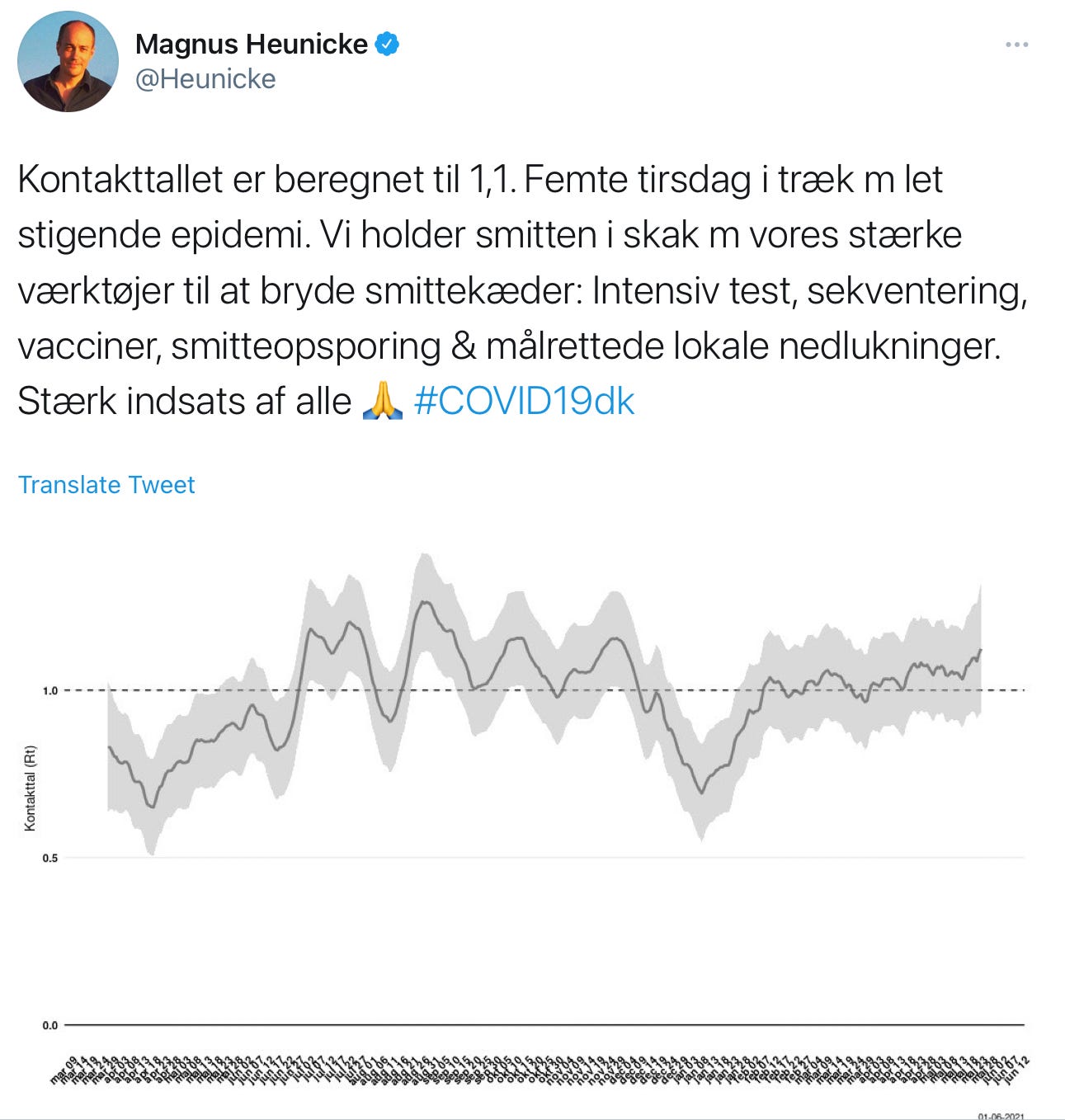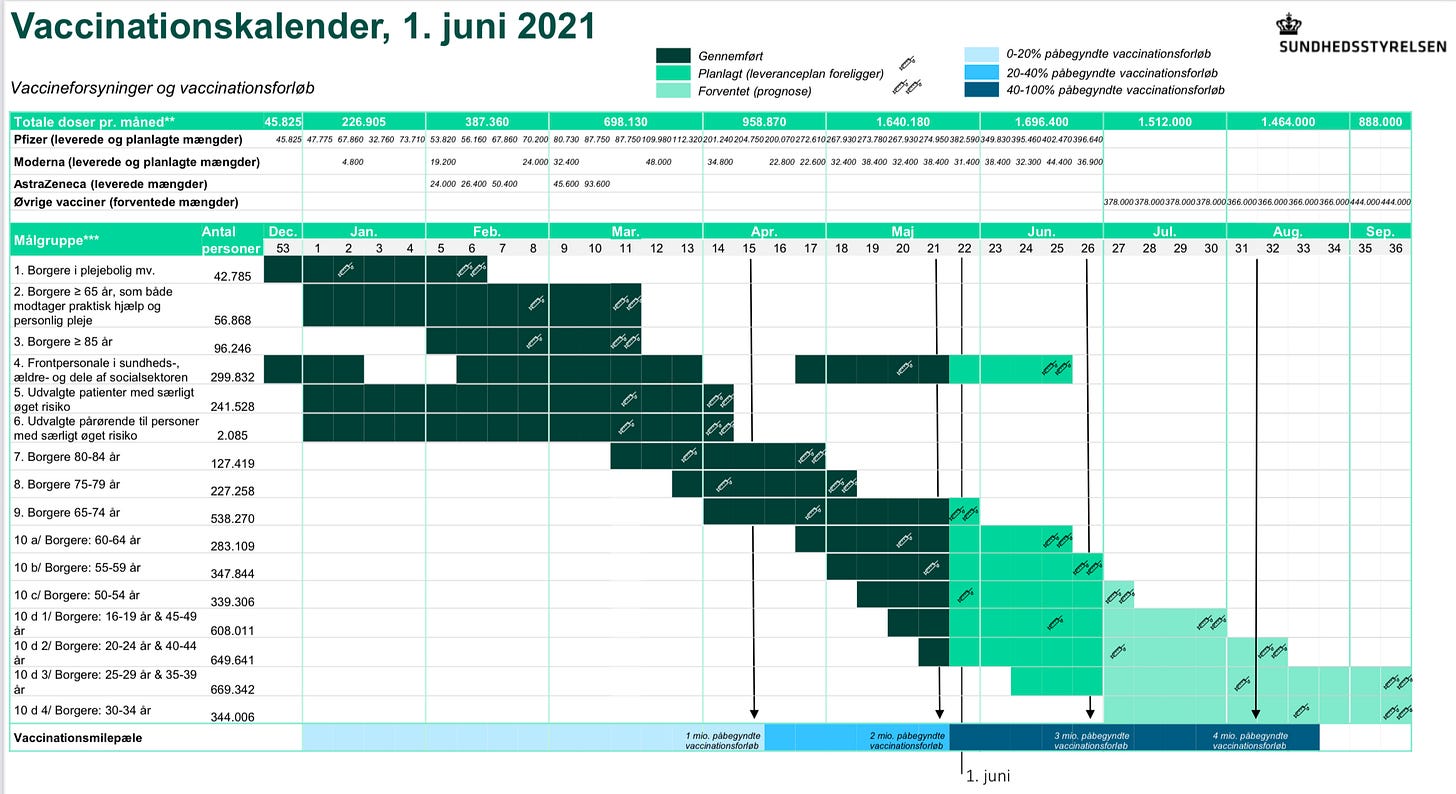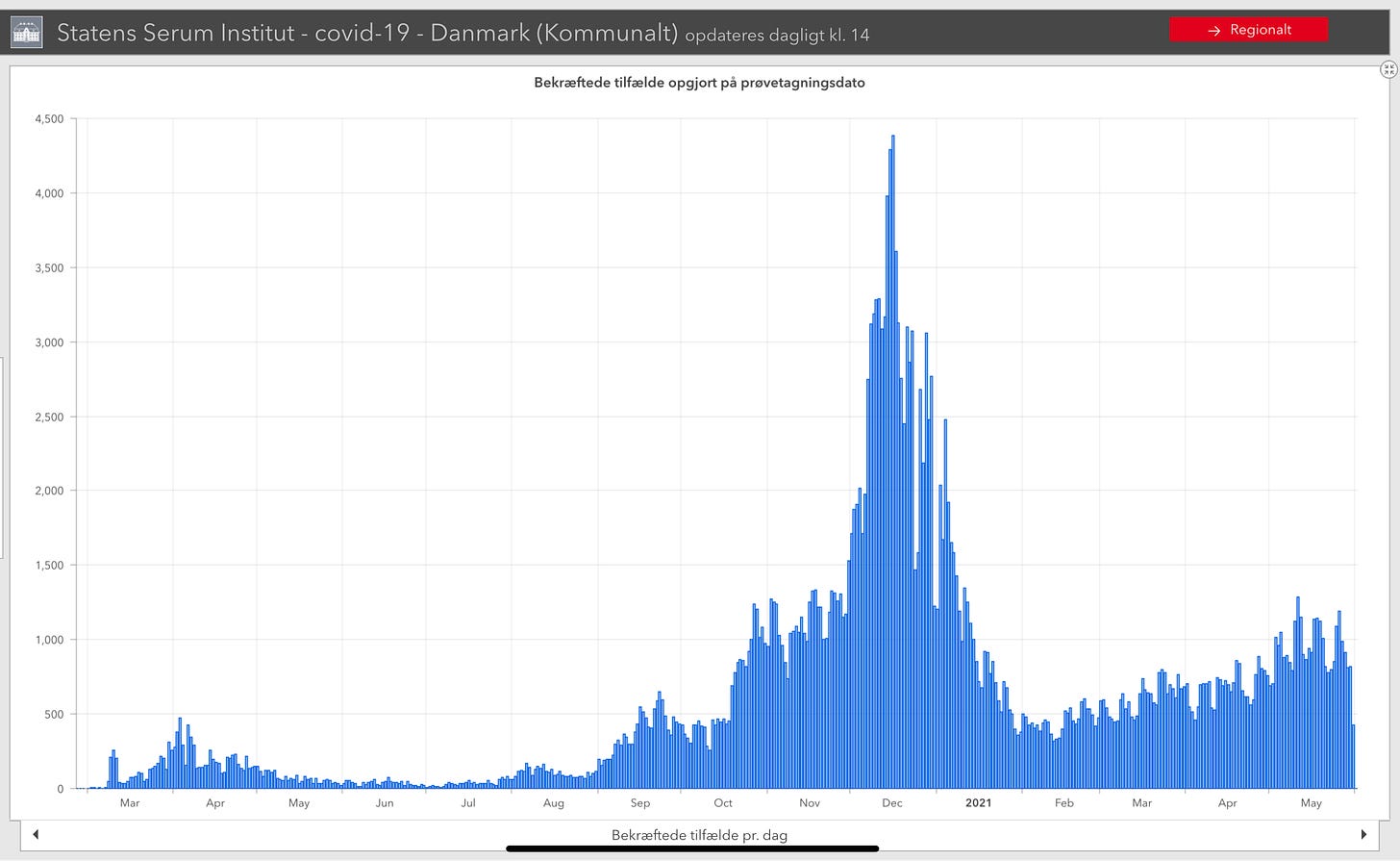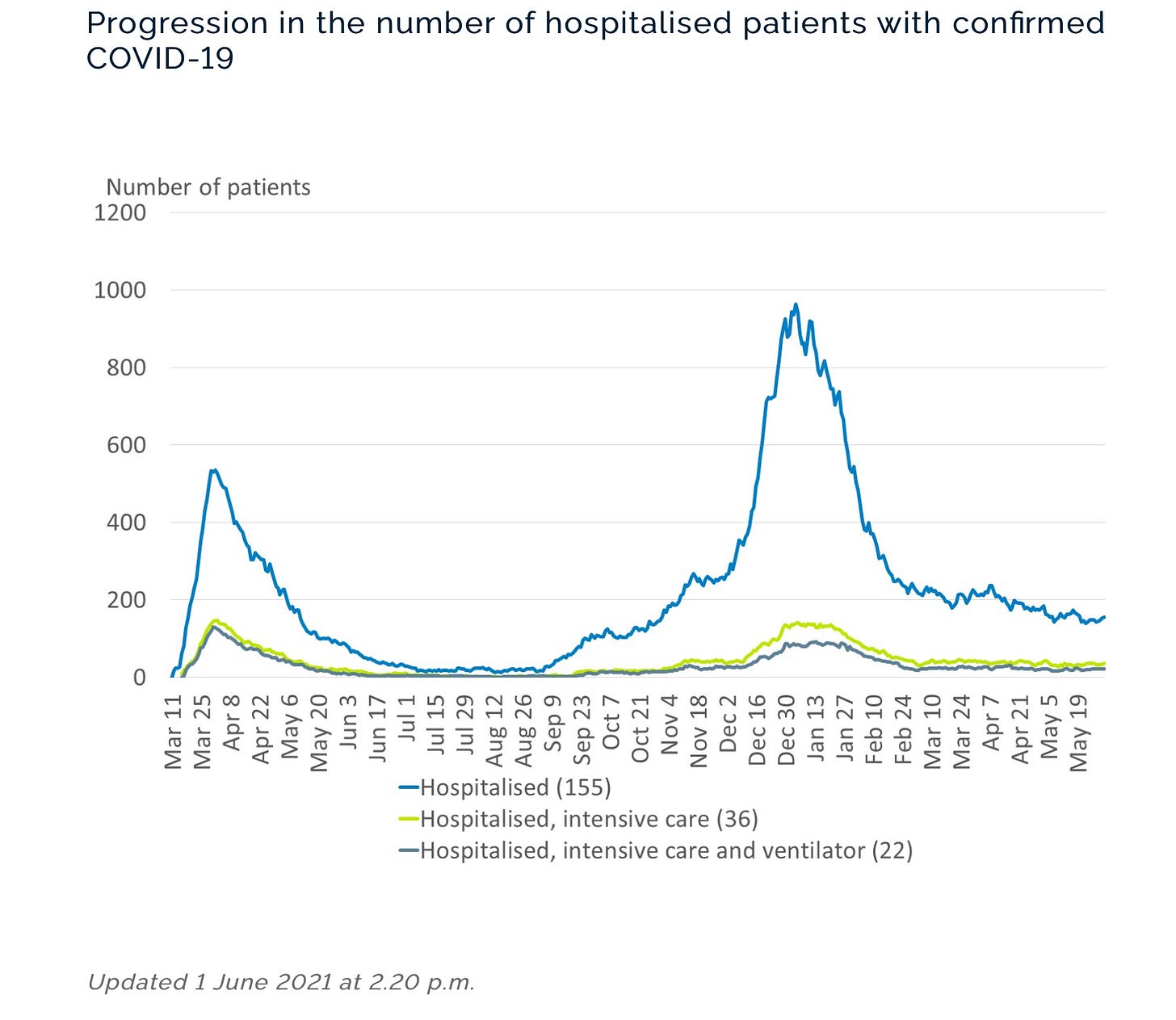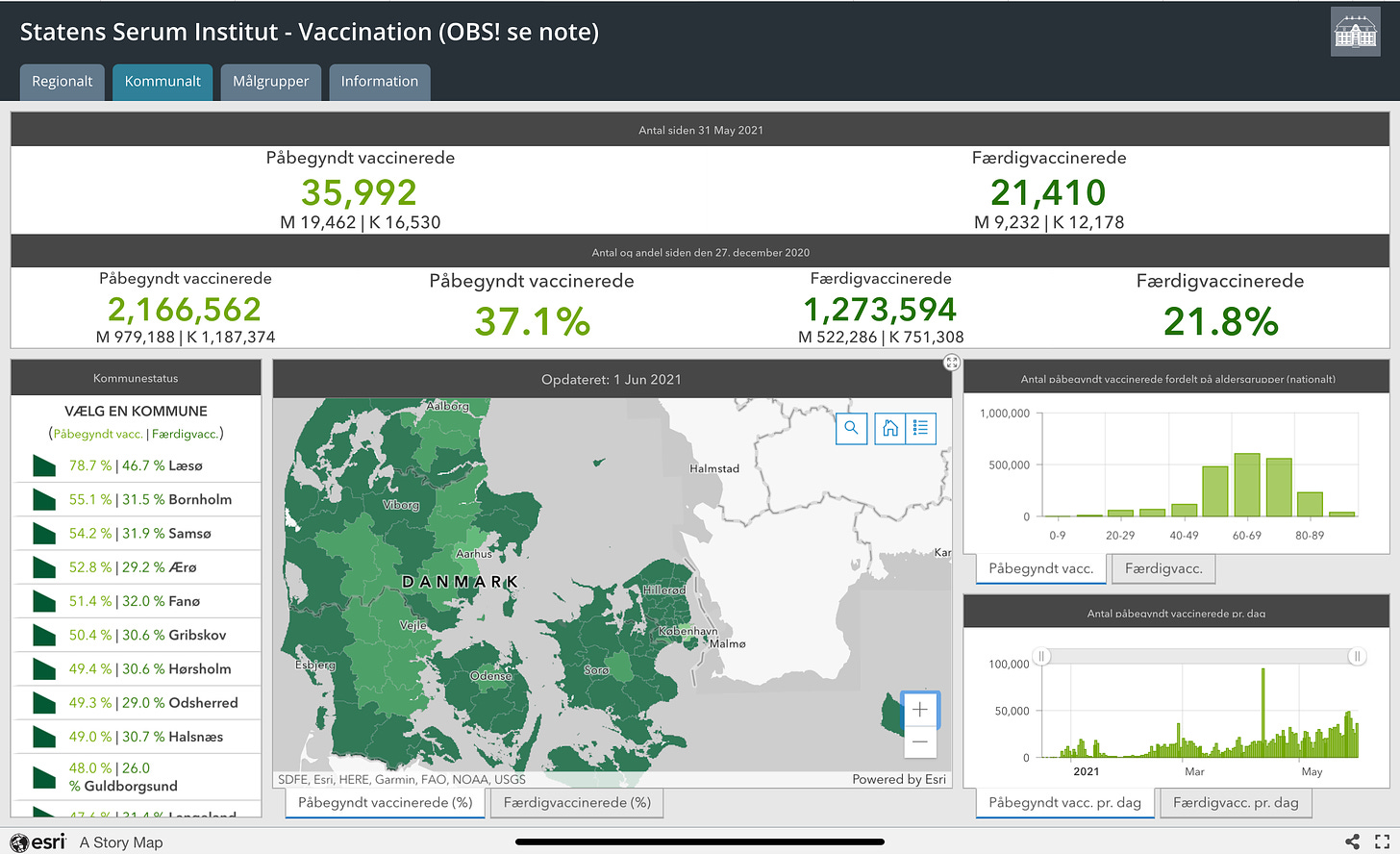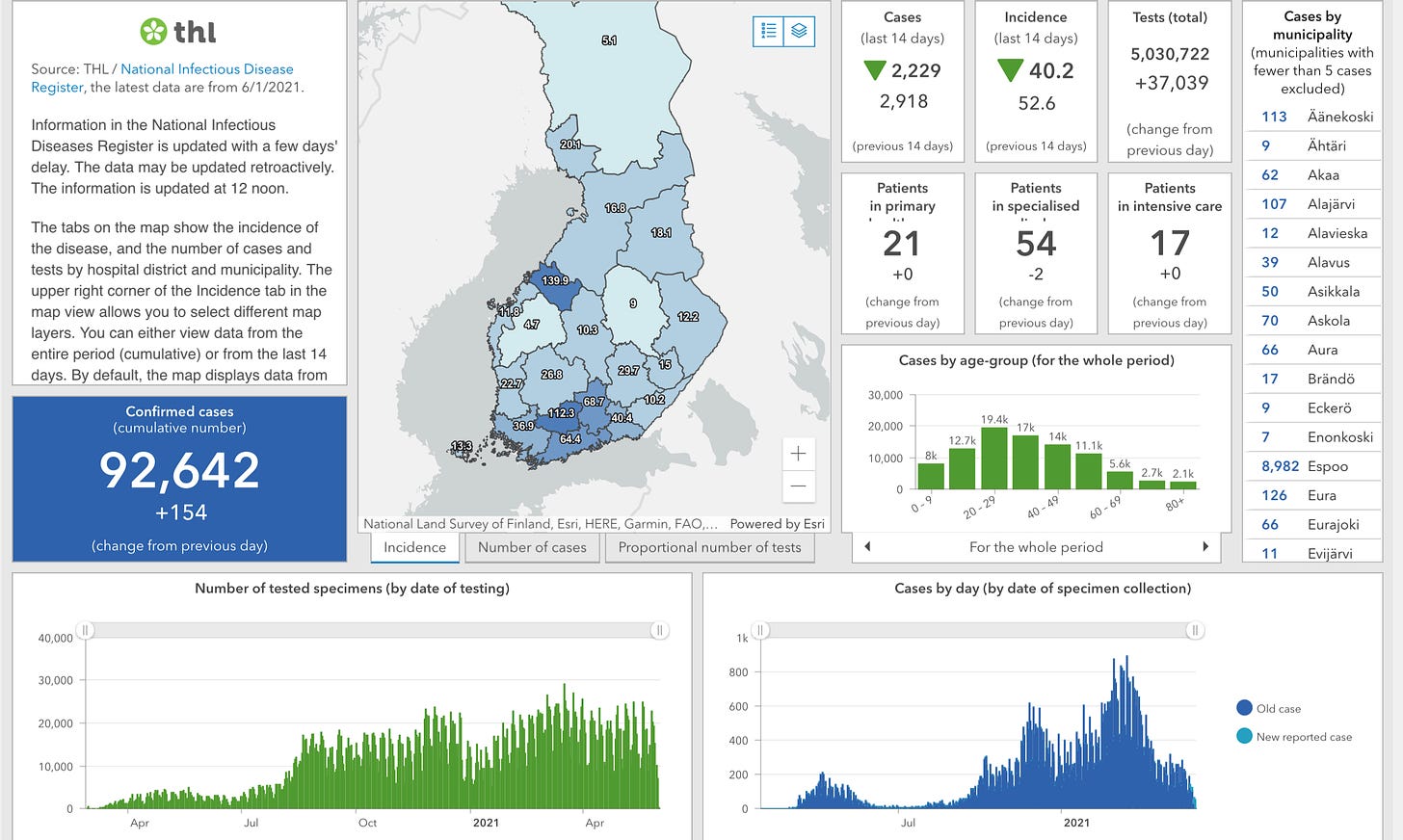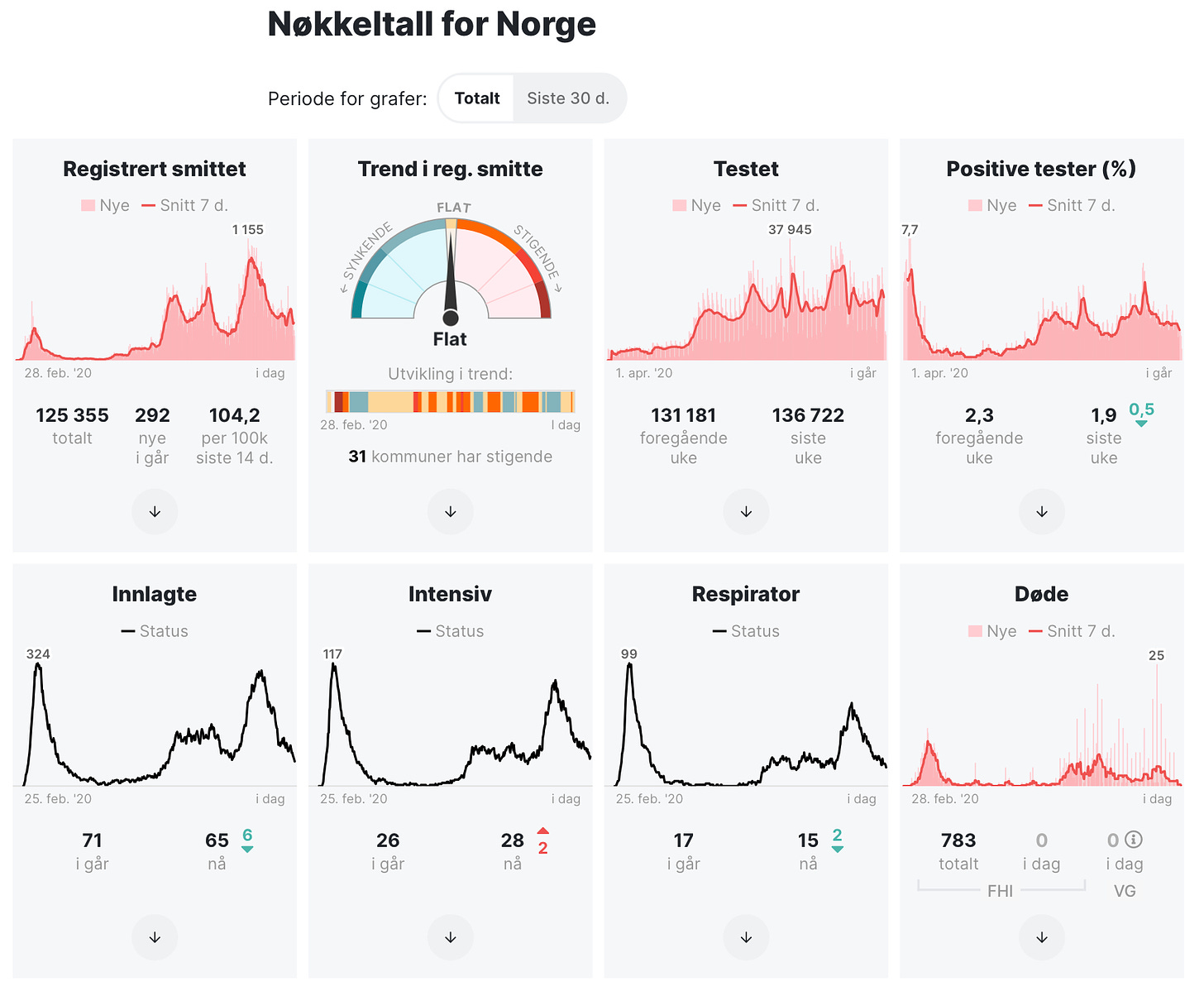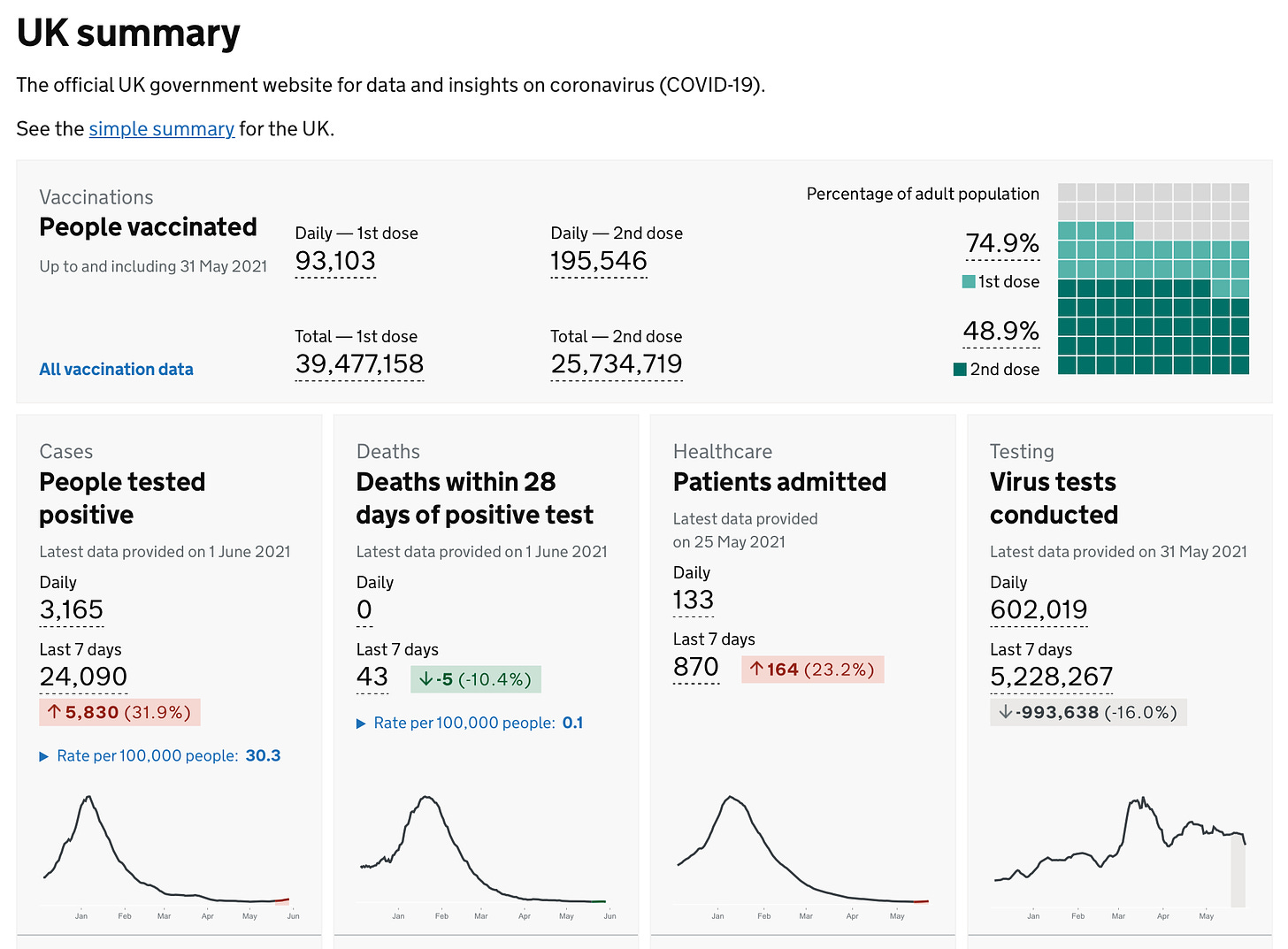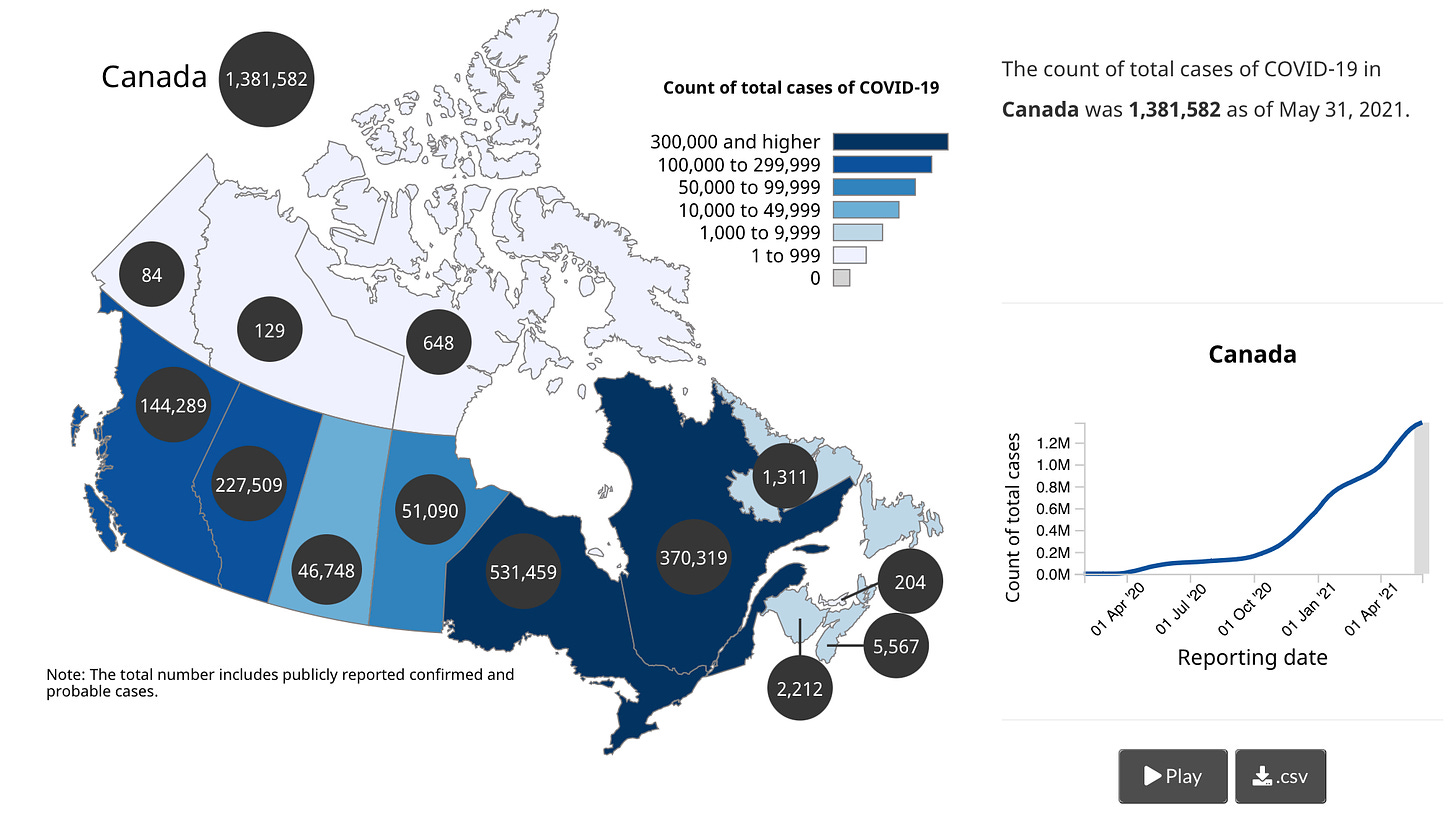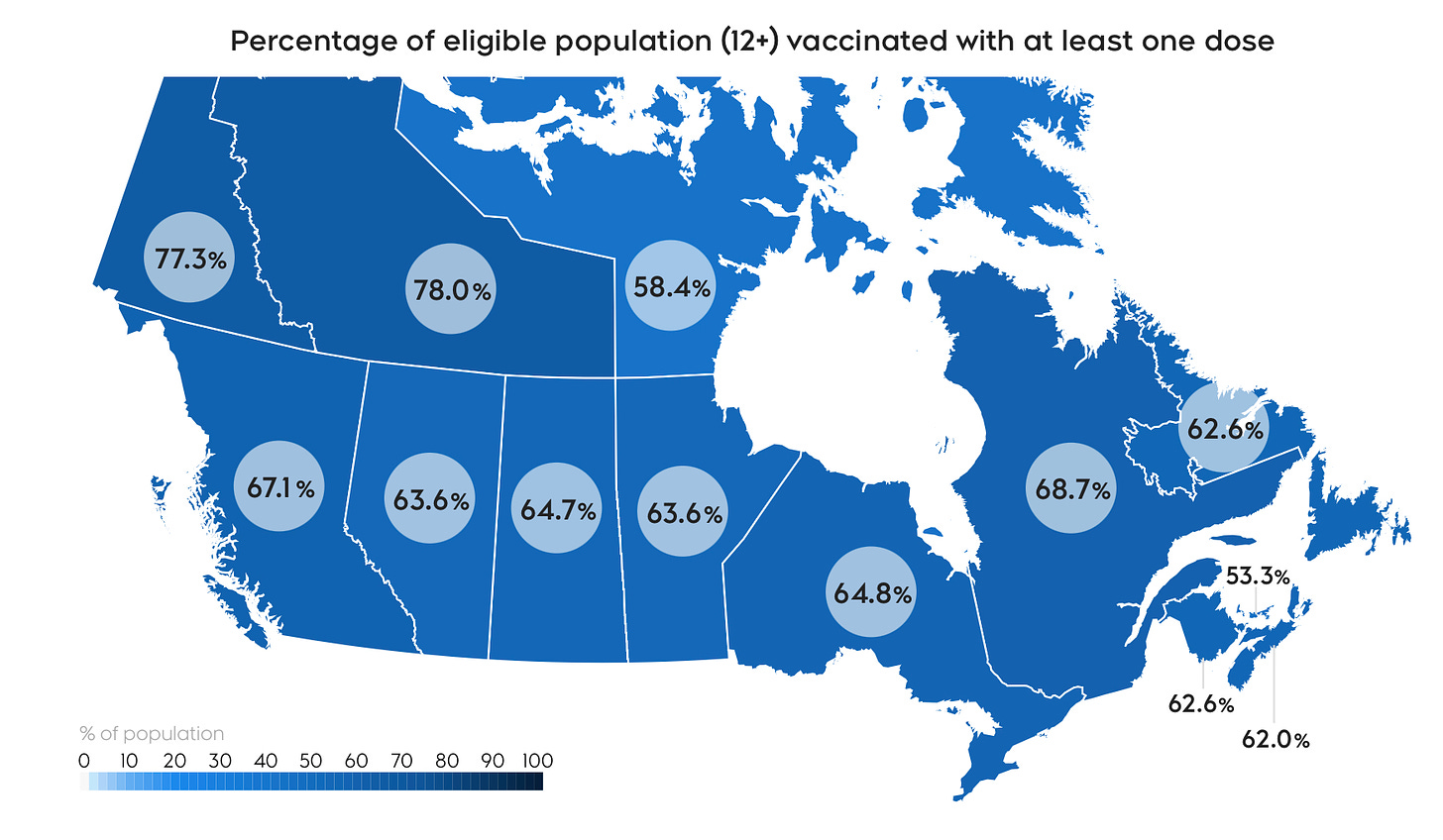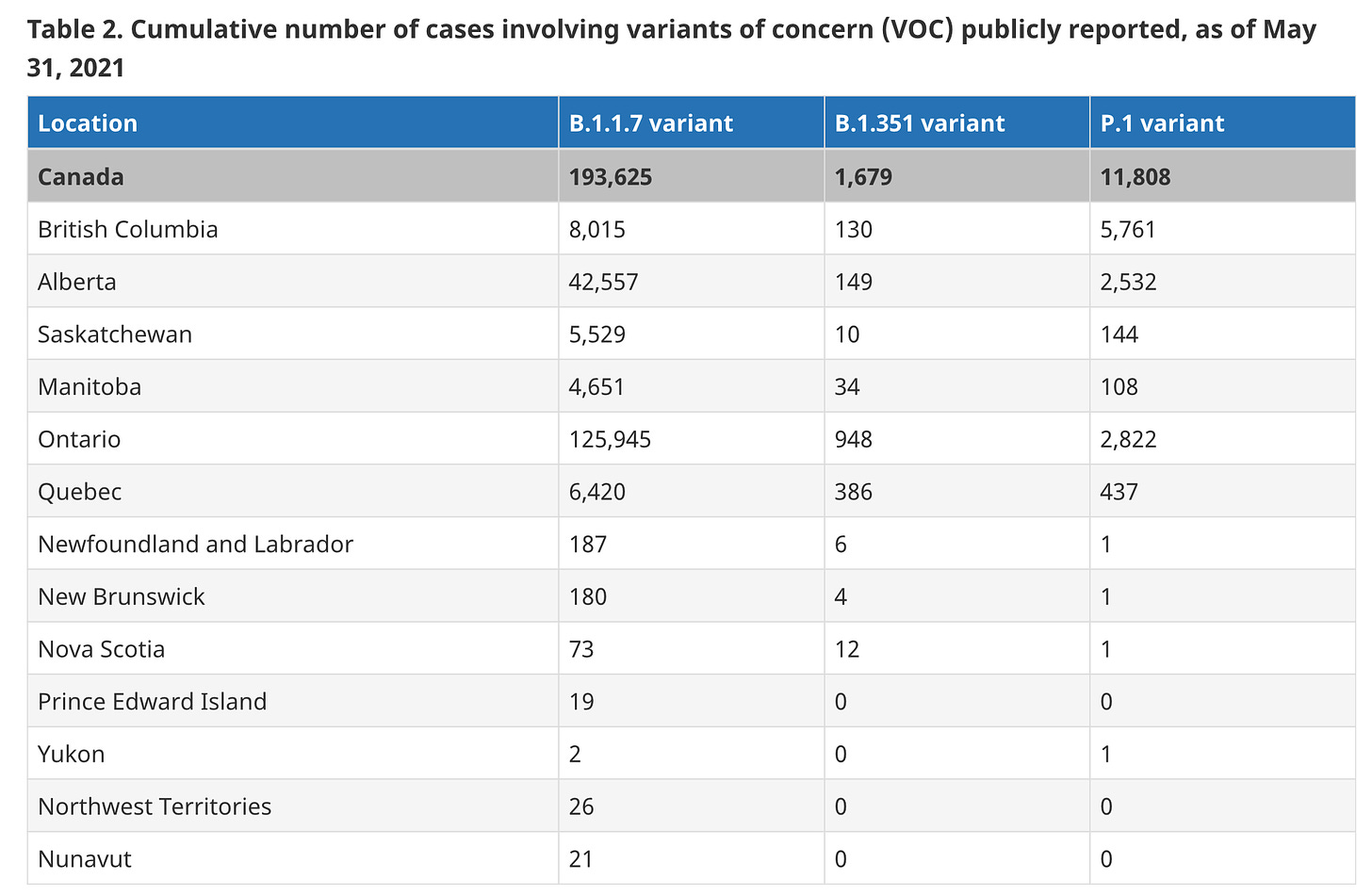🇩🇰🇪🇺
Denmark is among seven EU countries that have, as of today, already connected to the European Union gateway. It allows countries across the European Union to verify EU’s vaccine passports. Denmark can now begin issuing the EU digital COVID certificate. The EU GreenPass is virtually identical to Denmark’s coronapas. It allows travel across Europe with proof of vaccination, negative test, or immunity based on having a previous infection.
🇩🇰
For a fifth straight week, Denmark’s COVID contact number (R0 or reinfection rate) is treading water at 1.1. Health Minister Magnus Heunicke credits robust testing, sequencing positive test results, the vaccination effort, infection detection, and targeted local closures for keeping infections in check.
Denmark is hoping to have three-quarters of the population vaccinated by the end of July, beginning by really ramping up vaccinations this month. Up to 400,000 Pfizer doses will arrive each week in June and the Danish Health Authority plans to administer 300,000 vaccinations per week this month.
That said, we still haven’t seen anything remotely close to the 100,000 to 400,000 vaccinations per day that was promised months ago.
New age groups are about to be called to begin getting vaccinated. In the next two weeks, Sundhedsstyrelsen says, those 16 to 19 years old and people between 45 to 49 years of age will be on deck. They will be followed by 20 to 24-year-olds and then those 40 to 44-years-of-age. The two groups make up about 1.2 million people.
Health Board Deputy Director Helene Bilsted Probst:
“We have come so far in the vaccination effort that all regions are in the process of inviting the youngest cohorts to get their first vaccination. Combined with the fact that we have now rounded two million people who have received the first dose, it shows that we have come very far in ensuring a large degree of immunity in the population.”
Also on the good news front, health staff continue to squeeze more doses out of each Pfizer vial. New withdrawal methods and mixing residual vaccines from each vial have pushed doses per vial from five to seven. The utilization rate for the Pfizer vaccine is 114%.
The bad news is that the Curevac vaccine has not yet been approved for use and that far fewer Moderna doses are coming In July and August. This is why the vaccination calendar has been delayed again.
“It annoys me, of course, that we do not get all the vaccines we had expected, especially for younger people have to wait a few weeks longer to begin the vaccination process, but at the same time I am pleased that we in cooperation with the regions and the other agencies in the vaccination effort are constantly succeeding in improving the use of the vaccines we have available. And of course it also means that if the vaccine manufacturers start to catch up on some of what they have lost, we will be able to quickly adapt the vaccination efforts and speed up the roll-out.”
The vaccination delays mean four target groups covering people aged 16 to 49 will have to wait a few weeks later than planned before they get called to begin vaccinations.
-
The Danish Health Authority (Sundhedsstyrelsen) has updated the vaccination calendar officially pushing the end date to get everyone vaccinated to September 17th.
-
The Vice-Director of the Nordsjælland hospital, Jonas Egebart, says Region Hovedstaden (Metro Copenhagen) has now surpassed one-million people who are “either invited, have booked an appointment, or have been vaccinated.”
-
Denmark has reported 908 COVID infections and had no new coronavirus deaths in the last day.
Yesterday there were 662,103 total corona tests done, 131,512 PCR and 530,591 rapid, for a (PCR only) positivity percentage of 0.69%.
COVID hospitalizations (155) has increased slightly (+2) while the number of infected people in an ICU (36) also rose slightly (+2) of those the number on a ventilator (22) is unchanged.
On the vaccination front, to date 2,166,562 1st dose vaccinations (37.1% of the population) have been administered while 1,273,594 people (21.8%) are now fully vaccinated.
-
Region Syddanmark has tabled its weekly vaccination report. The Southern Denmark Health Authority received 92,769 vaccine doses this week, most of them Pfizer doses. The 13,200 Moderna doses will continue to go to completing vaccinations for health care workers who had one dose of AstraZeneca.
This week, the health agency will continue vaccinations for all priority groups currently on deck, including those just called to begin vaccinations: those 44 to 49 years old and young people aged 16 to 19. To date, 445,273 people living in the region (36.4%) have had one vaccine dose, while 274,203 people (22.4%) have had both.
-
The Danish Health Authority has approved using a steroid used to treat asthma for use among hard-hit, but not hospitalized COVID patients. Budesonide is an inhalant that helps prevent inflammation of the lungs. If used for two weeks, it can speed up recovery from the coronavirus. However, it does have side effects like coughing or mouth fungus, both of which dissipate once the treatment is stopped. The health authority also states “it is uncertain whether the treatment reduces the risk of hospitalization or death.”
The Health Board’s Simon Tarp:
“We believe the beneficial effects outweigh the disadvantages for those patients who are plagued by symptoms. This is a cheap treatment, therefore we believe the treatment can be considered.”
🇸🇪
Sweden won’t update its COVID numbers until Thursday due to its infectious disease database being the subject of hacking attempts.
-
Sweden began relaxing COVID restrictions easing rules and gathering caps on for public events along with raising the number of people who can go into a restaurant, amusement park, or outdoor sporting events, and competitions.
The Swedish Public Health Agency has published a table laying out how many people are allowed in any number of different events, gathering, and in different venues.
You can find the table, in Swedish, HERE
🇫🇮
Finland has registered 154 infections and had no new corona deaths since yesterday’s update.
The vaccination campaign has inoculated 2,476,248 people for the first dose (44.4% of the population) while 500,403 people (9%) are now fully vaccinated.
-
The Finnish Institute for Health is now recommending pregnant women get vaccinated against the coronavirus. It has revised recommendations after pouring over all the available data on the subject. The Institute says while the data is limited, there hasn’t been any research to date or real-world data from vaccinating pregnant women in other countries showing any concerns.
Institute Specialist Doctor Emma Kajander:
“A pregnant woman should especially consider getting vaccinated if she has an increased risk of developing coronavirus disease due to underlying health conditions. Vaccination should also be considered in cases where a pregnant woman is at increased risk of exposure to COVID, for example at work.”
The institute also says if a woman has had one vaccine dose and then gets pregnant, it is okay to get a second dose also that fertility treatments do not need to be postponed due to vaccination.
🇳🇴
Norway has added 374 infections and had no new virus deaths since yesterday’s update.
COVID hospitalizations (65) are down (-6) ICU numbers (28) have inched up (+2) while ventilator numbers (15) slipped down (-2).
To date 30.43% of Norwegians have had one vaccine dose while 18.79% have had both doses.
-
The Norwegian Health Institute says its infection-detection app, smittestop, has been upgraded to better detect close contacts. The health agency says provided everyone around a person also uses the app if they become infected and report it, then the app can detect and notify 93% of close contacts. Presumably those people would also get tested, breaking the chains of infection.
As of May 30th, 1,022,100 people had downloaded the Smittestop app.
🇩🇪
German Health Minister Jens Spahn says children and adolescents “who, after making an individual decision with their parents” can begin to be vaccinated across Germany. Spahn says they want to have all children who want to be vaccinated a first dose by the end of August.
Last Friday, the European Medicines Agency approved an application by Pfizer to expand use of its vaccine to children as young as 12. The European Union rubber-stamped the approval today, allowing all member nations to begin vaccinating children with the Pfizer/BioNTech vaccine.
🇬🇧
For the first time since the pandemic began the United Kingdom has recorded no coronavirus deaths in the last day.
🇵🇪
Peru has done an audit of its COVID deaths. The result? A threefold increase in coronavirus fatalities to 180,000. In making the correction, it checked tens of thousands of death certificates after multiple media reports, citing excess death statistics, said the country was vastly under-counting coronavirus deaths.
The result in Peru could be an indicator of what will likely be a big increase in global deaths due to under-reporting of pandemic fatalities. Some reports, again citing excess global death statistics, say the global virus death toll could be more than double the current 3.5 million global corona fatalities reported to date.
🇨🇦
Canada has reported 2,118 new infections and suffered another 35 coronavirus deaths yesterday as its numbers continue to decline.
On the Canadian vaccination effort, to date 21,784,583 1s dose vaccinations (57.32% of the population over 12) while 2,076,739 people are now fully vaccinated.
Even as overall infections decline COVID variants continue to gain more ground with B.C. leading all provinces with the number of Gamma (P1) variants while Ontario has far and away the most Alpha (B.1.1.7) variant infections.
Noticeably absent from the chart is the new variant threat, the Delta variant or B.1.617.2. Infections have been confirmed in several provinces so the variant has arrived in Canada.
In Ontario today Health Minister Christine Elliott tweeted “Ontario is reporting 699 cases of #COVID19 and nearly 20,300 tests completed. Locally, there are 207 new cases in Toronto, 144 in Peel, 52 in York Region and 50 in Durham. As of 8:00 p.m. yesterday, 9,202,220 doses of the COVID-19 vaccine have been administered.” There were also 13 more deaths.
Quebec reported 208 infections and five deaths.
In Atlantic Canada, Newfoundland and Labrador had six infections. New Brunswick five. Nova Scotia has yet to report.
Manitoba had 303 infections and one more virus death yesterday, these numbers are under-reported due to a technical issue according to the province.
There were 113 infections and one death in Saskatchewan yesterday.
Alberta recorded 263 infections and eight more deaths yesterday as it forges ahead with a first phase of reopening.
B.C. registered 708 infections and eight deaths in numbers covering the three days.





